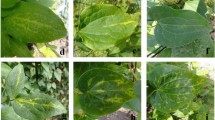Abstract
Many of the world’s most important citrus cultivars (”Washington Navel”, satsumas, clementines) have arisen through somatic mutation. This phenomenon occurs fairly often in the various species and varieties of the genus.The presence of copia-like retrotransposons has been investigated in fruit trees, especially citrus, by using a PCR assay designed to detect copia-like reverse transcriptase (RT) sequences. Amplification products from a genotype of each the following species Citrus sinensis, Citrus grandis, Citrus clementina, Prunus armeniaca and Prunus amygdalus, were cloned and some of them sequenced. Southern-blot hybridization using RT clones as probes showed that multiple copies are integrated throughout the citrus genome, while only 1–3 copies are detected in the P. armeniaca genome, which is in accordance with the Citrus and Prunus genome sizes. Sequence analysis of RT clones allowed a search for homologous sequences within three gene banks. The most similar ones correspond to RT domains of copia-like retrotransposons from unrelated plant species. Cluster analysis of these sequences has shown a great heterogeneity among RT domains cloned from the same genotype. This finding supports the hypothesis that horizontal transmission of retrotransposons has occurred in the past. The species presenting a RT sequence most similar to citrus RT clones is Gnetum montanum, a gymnosperm whose distribution area coincides with two of the main centers of origin of Citrus spp. A new C-methylated restriction DNA fragment containing a RT sequence is present in navel sweet oranges, but not in Valencia oranges from which the former originated suggesting, that retrotransposon activity might be, at least in part, involved in the genetic variability among sweet orange cultivars. Given that retrotransposons are quite abundant throughout the citrus genome, their activity should be investigated thoroughly before commercializing any transgenic citrus plant where the transgene(s) is part of a viral genome in order to avoid its possible recombination with an active retroelement. Focusing on other strategies to control virus diseases is recommended in citrus.
Similar content being viewed by others
Author information
Authors and Affiliations
Additional information
Received: 10 December 1998 / Accepted: 28 December 1998
Rights and permissions
About this article
Cite this article
Asíns, M., Monforte, A., Mestre, P. et al. Citrus and Prunuscopia-like retrotransposons. Theor Appl Genet 99, 503–510 (1999). https://doi.org/10.1007/s001220051263
Issue Date:
DOI: https://doi.org/10.1007/s001220051263




